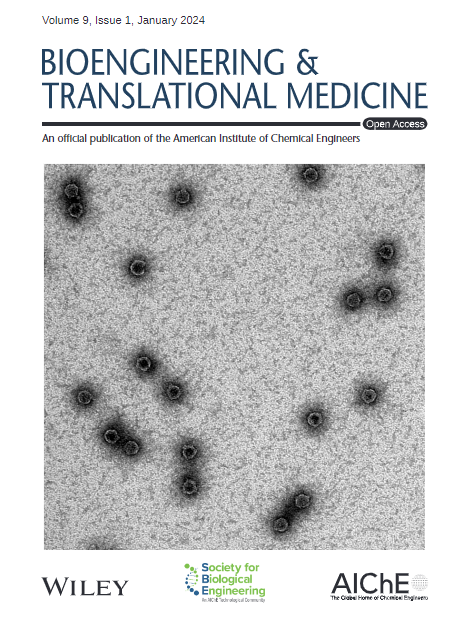肾靶向外泌体抑制miR - 182 - 5p治疗肾缺血再灌注损伤
IF 5.7
2区 医学
Q1 ENGINEERING, BIOMEDICAL
引用次数: 0
摘要
肾缺血再灌注损伤(肾缺血再灌注损伤,肾缺血再灌注损伤)是导致急性肾损伤的重要疾病,在临床上加速肾功能衰竭的进展,影响患者的预后。在确定miR - 182 - 5p为IRI中的重要分子后,我们对其潜在的下游基因进行了详细分析,并评估了其在SIRT1/Nrf2/ferroptosis通路中的作用。为了在体内验证这些发现,我们实施了外泌体介导的给药方案,并评估了其对C57BL/6的治疗效果。miR‐182‐5p在肾IRI中表现出显著的上调。本研究利用生物信息学方法进一步研究并验证了其下游SIRT1/Nrf2通路,确定了其在铁下垂中的作用。通过使用LTHVVWL(LTH)锚定的外泌体,miR - 182 - 5p向肾脏的递送显著改善,从而表明其在减轻肾脏IRI方面的潜在疗效。我们的研究结果表明miR - 182 - 5p抑制SIRT1/Nrf2活性并促进铁下垂,这表明它有可能成为临床IRI治疗的治疗靶点。通过LTH锚定外泌体抑制miR - 182 - 5p被证明可以显著减轻肾脏IRI,为开发基于miRNA的治疗性药物传递系统提供了一种新方法。本文章由计算机程序翻译,如有差异,请以英文原文为准。
Renal‐targeted exosomes inhibiting miR‐182‐5p for treatment of renal ischemia–reperfusion injury
Renal ischemia–reperfusion injury (IRI) is a significant condition that leads to acute kidney injury, exacerbating the progression of renal failure clinically and affecting the patient's prognosis. Following the identification of miR‐182‐5p as a significant molecule in IRI, we conducted a detailed analysis of its potential downstream genes and assessed its involvement in the SIRT1/Nrf2/ferroptosis pathway. To validate these findings in vivo, we implemented an exosome‐mediated drug delivery protocol and assessed its therapeutic efficacy in C57BL/6. miR‐182‐5p exhibited a notable upregulation in renal IRI. Utilizing bioinformatics approaches, the study further investigated and validated its downstream SIRT1/Nrf2 pathway, establishing its role in ferroptosis. By employing LTHVVWL(LTH)‐anchored exosomes, the delivery of miR‐182‐5p to the kidney was significantly improved, thereby illustrating its potential efficacy in mitigating renal IRI. The findings of our study demonstrated that miR‐182‐5p suppressed SIRT1/Nrf2 activity and facilitated ferroptosis, suggesting its potential as a therapeutic target for clinical IRI treatment. The inhibition of miR‐182‐5p via LTH‐anchored exosomes was shown to significantly mitigate renal IRI, providing a novel approach for the development of miRNA‐based therapeutic drug delivery systems.
求助全文
通过发布文献求助,成功后即可免费获取论文全文。
去求助
来源期刊

Bioengineering & Translational Medicine
Pharmacology, Toxicology and Pharmaceutics-Pharmaceutical Science
CiteScore
8.40
自引率
4.10%
发文量
150
审稿时长
12 weeks
期刊介绍:
Bioengineering & Translational Medicine, an official, peer-reviewed online open-access journal of the American Institute of Chemical Engineers (AIChE) and the Society for Biological Engineering (SBE), focuses on how chemical and biological engineering approaches drive innovative technologies and solutions that impact clinical practice and commercial healthcare products.
 求助内容:
求助内容: 应助结果提醒方式:
应助结果提醒方式:


